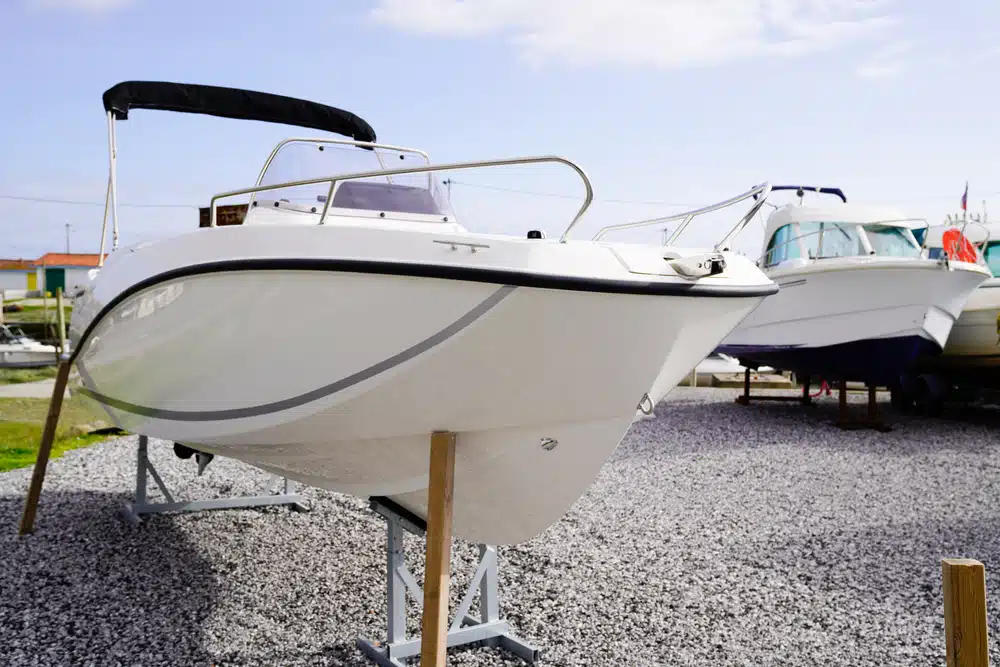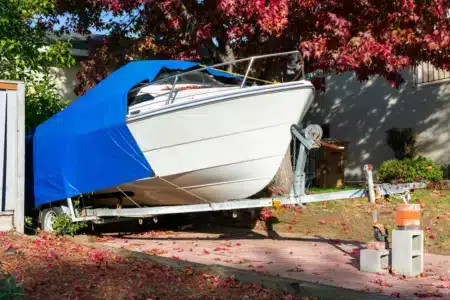
When not in use, you’ll probably need somewhere to store your boat. Keeping it in the water is a bad idea, as it puts your boat at risk for weather-related damage or rusting. If you want to keep it at home, either in your driveway or garage, it will take up valuable space you could use for other vehicles.
Living in a neighborhood that doesn’t allow residents to keep boats, campers or RVs in their driveways? You could build a custom shelter or take the easy way out and rent space at a self-storage facility.
Whether you want to know how to store a boat outside or at home, we’ll help you find the best spots to store it when not in use, from garages to professional facilities and beyond. We’ll also cover boat winterization basics with a dash of boat maintenance during storage.
This being said, welcome to your go-to guide for both short-term and long-term boat storage!
Preparing Your Boat for Storage
Getting your boat ready for storage isn’t one-size-fits-all — it changes with the seasons and where you are. If you’re up north or somewhere chilly, you’ll want to winterize your motorized boat to handle the freezing temps.
But no matter the climate, long-term boat storage prep starts the same way: with the owner giving their vessel a good cleaning and a thorough once-over for any needed fixes.
Boat cleaning and inspection
Time to get your boat ready for a little downtime!
Step 1. Give the whole boat a good wash to get rid of salt, dirt and all that gunk.
Step 2. Post-wash, make sure every nook and cranny is dry. Extra attention on the bilges and any other spots water might want to hide will help keep mold and mildew at bay.
Step 3. Inspect the hull for any signs of trouble like cracks or blisters — better to catch them now than on your next adventure.
Step 4. Check the propeller for nicks or dents and clear out any tangled fishing line that might mess with your boat’s groove.
Step 5. Check that your electronics are functional and, if you’re not storing the boat at home, strip it of any valuables or gear that shouldn’t sit there during long-term boat storage.
Winterizing boat engines and systems
When it’s time to cozy up your boat for the cold, remember that every boat model is slightly different, so it’s best to consult your owner’s manual before changing the oil or flushing the engine. With the manual by your side, here’s what you’ll want to do for boat winterization:
- Fill the fuel tank and add fuel stabilizer to prevent any condensation and separation.
- Drain the boat, engine and all lines of water. Then, flush the engine block with a high-quality, non-toxic marine antifreeze.
- Check the drive oil, engine oil, fluids in the lower gear shaft and all other fluids for any remaining water that could expand over the winter.
- If applicable, winterize all freshwater and wastewater holding tanks, as well as generators and air conditioning systems.
Boat interior preparation
Keep the inside of your boat just as ready as the outside with proper ventilation, moisture absorbers, good cleaning and protective covers.
- Keep air vents open and, if possible, slightly open a window or hatch to promote circulation and ward off dampness.
- Tuck tiny silica gel packs in drawers, cabinets and other enclosed spaces.
- Vacuum carpets, wipe down surfaces and clean all upholstery. Once everything is perfectly dry, use protective covers on furniture to guard against dust and moisture.
Choosing the Right Boat Storage Option

Whether you’re storing your boat at home (in a garage or shed), at a storage facility with extra security or simply prefer the great outdoors, each option has its merits, so weigh them based on your needs, budget and convenience to find the perfect winter home for your boat.
Storing a boat at home

If your boat fits and you don’t have other vehicles that need to get in and out, the garage is a great place to store it away from the elements. A quick note, though: Make sure there’s enough room to walk around for easy access and maintenance — measure twice, park once!
No garage space? Build or buy a custom shelter. A simple canopy or a more robust boat house can shield your vessel from weather woes.
Outdoor boat storage

Cover and ground are key when storing a boat outside, so look for a high-quality boat cover and choose a spot with good drainage to avoid pooling water. Here are a few additional pointers:
- The best boat covers are tough enough to handle the weather in your area — whether it’s UV rays, rain or snow.
- The most cost-effective method is tying a plastic tarp to the boat, jack stands or cradle. A tarp prevents mildew because it provides airflow and ventilation. However, tarp ties could cause chafing, and this method will only last through one off-season.
- Gravel or paving stones can prevent sinking and stabilize the boat, while keeping it mud-free.
Pro tip: Use tie-downs to anchor your boat to the ground. They prevent it from tipping over or shifting during strong winds.
Choosing a boat storage facility near you
Facilities typically offer indoor, outdoor, and covered storage spaces for boats. Specialized ones also have dry stack storage options that use a fork lift to store boats on specialized racks that maximize space.
Indoor units cost more but offer the best protection from the elements, while outdoor boat storage is often the most budget-friendly. Covered storage provides a popular middle ground, and cost-effectiveness may be the biggest of all dry stack storage benefits.
Looking at indoor options and not sure about the unit size you need? The smallest boats can easily fit in a 10’x15’ unit — if you have a larger model, go for a 10’x20’ or even a 10’x30’ unit just to be sure.
For ultimate protection, opt for a climate-controlled unit. Since it regulates temperature and humidity, this is your best bet for sensitive finishes and electronics. Also, choose a facility with good security measures like gated access, surveillance cameras and on-site staff to keep an extra eye on things.
Pro tip: Some facilities offer additional perks like boat maintenance services or battery charging stations, a real boon during the off-season.
Maintaining Your Boat in Storage
While your boat’s parked for the off-season, a little vigilance goes a long way:
- Regularly inspect your boat cover for any tears or weaknesses.
- Set traps inside and around your boat to catch any sneaky critters looking for a winter home.
- Moisture control in boat storage should be a top priority, so keep an eye out for any signs of moisture or mold build-up in closed areas.
- Disconnect the battery, give it a full charge and store it safely on a wooden surface at home. Hook up a trickle charger to keep the battery fresh without overdoing it.
- Periodically check the battery for corrosion or other signs of wear and deal with problems as soon as they pop up.
Security and Legal Considerations
Whether storing a boat at home or in a storage facility, the first line of defense among all boat storage security measures consists of a sturdy lock and a loud alarm.
If you’re storing your boat outside, ensure it’s under some bright lights and install some cameras around it. Well-lit areas are key in preventing boat theft and cameras give you eyes on it when you’re not there.
Now, security isn’t everything to consider — you must also comply with local laws. The thing is, some places have rules about where and how you can store a boat, and a quick check with local authorities or your HOA can save you from fines.
Insurance matters, too. Call your agent to confirm you’re covered for long-term boat storage, especially if you change storage spots.
The Cost of Storing a Boat
From basic outdoor spots to fancy indoor shelters, choosing the right storage can impact your wallet, as storage costs can vary like the ocean waves. As we mentioned before, outdoor spaces are cheaper but offer less protection. Indoor storage (especially if climate-controlled) costs more but keeps your boat cozy and safe from the elements.
Size matters, too. Bigger boats need bigger spaces, which can mean bigger bills. Measure your boat to ensure you’re not paying for more space than you need, but leave enough room around it to perform maintenance easily.
Pro tip: Handling some tasks yourself, like winterizing your boat, can reduce costs at facilities that charge for extra services.
Now You Know How To Store a Boat
Ready to dock your boat in the perfect spot? Consider what it needs, what your budget allows and how the seasons affect your region. When you bought it, your boat probably cost you a good chunk of change, so don’t let it rust, grow mold, have chipped paint or get cracked seat cushions.
Storing a boat at home or at a facility, winterizing it, securing it and finding the best boat covers may seem like a hassle upfront, but it will protect your boat when you’re not using it. With the right plan, you can sail smoothly into long-term boat storage without a worry.




